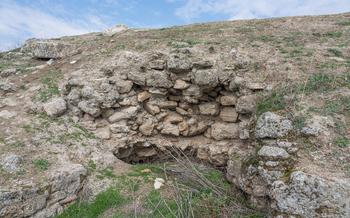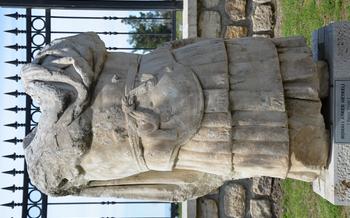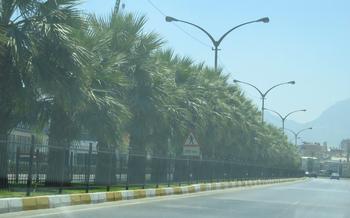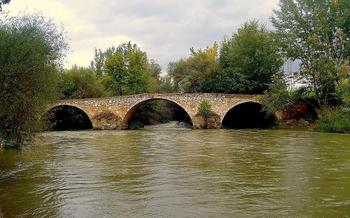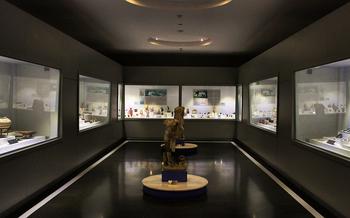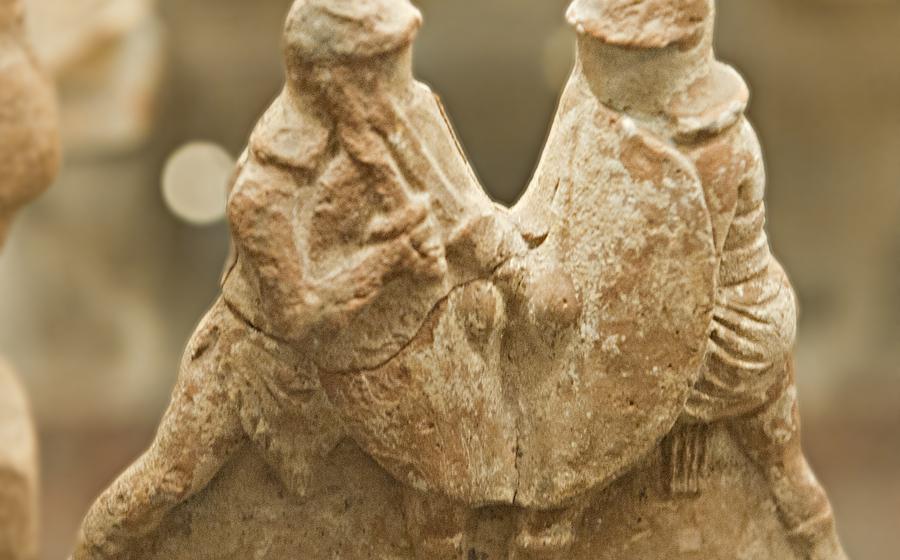
The Antique Pool of Hierapolis
- The Antique Pool of Hierapolis: A Unique Experience
- Location and Getting There
- Admission and Opening Hours
- History of Hierapolis and the Pool
- Architectural Features and Design
- Thermal Springs and Healing Properties
- Bathing Rituals and Traditions
- Archaeological Excavations and Discoveries
- Restoration and Preservation Efforts
- Surrounding Attractions and Landmarks
- Tips for a Memorable Visit
- Photography and Videography
- Accessibility and Facilities
- Local Cuisine and Delicacies
- Insider Tip: Hidden Gem
The Antique Pool of Hierapolis: A Unique Experience
The Antique Pool of Hierapolis, nestled amidst the ancient ruins of Hierapolis, Turkey, offers a captivating journey into the past and a unique immersion in ancient bathing culture. Once an integral part of this bustling Roman spa town, the pool stands as a testament to the ingenuity and craftsmanship of its creators. Its exceptional state of preservation and unique architectural features make it a must-visit for history buffs, architecture enthusiasts, and wellness seekers alike.
In the heart of the ancient city, the Antique Pool invites visitors to step back in time and experience the tranquility and healing properties that made Hierapolis famous in antiquity. With its pristine waters, impressive size, and intricate design, the pool stands as a symbol of ancient wellness practices and a testament to the enduring allure of this captivating historical site.
Location and Getting There
The Antique Pool of Hierapolis is situated in the ancient city of Hierapolis, which lies within the boundaries of modern-day Pamukkale, Turkey. To reach this historical site, you can take a scenic journey from major cities like Denizli or Izmir. From Denizli, you can hop on a local bus or rent a car to cover the approximately 20-kilometer distance. If you're coming from Izmir, the journey is longer, spanning around 250 kilometers, but the drive offers breathtaking views of the Turkish countryside. Once in Pamukkale, follow the signs leading to Hierapolis, where you'll find the Antique Pool nestled among the ancient ruins.
Admission and Opening Hours
To enter the Antique Pool of Hierapolis, you'll need to purchase an admission ticket. The current fee is 110 Turkish Lira (around $6) for foreign visitors, while Turkish citizens pay a reduced rate of 45 Turkish Lira. The pool is open to the public daily, with operating hours typically from 8 am to 6 pm. However, it's advisable to check for any seasonal adjustments or special arrangements before planning your visit.
If you're seeking a less crowded experience, consider visiting early in the morning or late in the afternoon, as these times tend to be quieter. On the other hand, if you prefer a more vibrant atmosphere, aim for the midday hours when the pool is bustling with activity.
History of Hierapolis and the Pool
Hierapolis, a mesmerizing ancient city in southwestern Turkey, owes its fame to its remarkable thermal springs and the magnificent Antique Pool. Founded in the 2nd century B.C. by Eumenes II, king of Pergamon, Hierapolis flourished as a renowned spa town, attracting visitors from far and wide seeking rejuvenation and healing in its therapeutic waters.
The Antique Pool, the centerpiece of Hierapolis's bathing culture, played a crucial role in the city's prosperity. Constructed in the 2nd century A.D., this architectural marvel served as a sanctuary for relaxation, healing, and social interaction. Its strategic location atop a natural travertine terrace allowed the pool to harness the geothermal waters that gushed forth from the earth's depths.
The pool's construction showcased the ingenuity and architectural prowess of the Romans. Massive travertine blocks, quarried from the surrounding hills, were meticulously assembled to create a colossal rectangular basin measuring an impressive 227 feet by 148 feet. Its depth varied from 3 to 5 feet, accommodating bathers of all ages and abilities.
Hierapolis's thermal springs, renowned for their healing properties, were believed to possess divine powers. According to ancient legends, the gods themselves bathed in these sacred waters, bestowing upon them miraculous healing abilities. The pool became a pilgrimage site for those seeking relief from ailments, injuries, and skin conditions.
Architectural Features and Design
The Antique Pool of Hierapolis stands as a testament to the architectural prowess of the ancient Romans. Constructed using locally sourced limestone and marble, the pool's impressive dimensions and intricate design elements showcase the engineering and artistic skills of its creators. Measuring approximately 140 meters in length and 120 meters in width, the pool is divided into two distinct sections: a large rectangular main pool and a smaller, hexagonal plunge pool.
The main pool features a series of steps leading down into the water, allowing bathers to gradually immerse themselves in the warm, mineral-rich waters. Surrounding the pool is a wide promenade, paved with marble slabs and lined with elegant columns. These columns, adorned with intricate carvings and sculptures, provide both structural support and a sense of grandeur to the bathing complex.
The hexagonal plunge pool, located at the far end of the main pool, is believed to have been used for therapeutic purposes. Its smaller size and deeper waters allowed bathers to fully submerge themselves and experience the healing properties of the thermal springs.
Overall, the Antique Pool of Hierapolis is a masterpiece of ancient architecture, combining functionality with aesthetic beauty. Its well-preserved state allows visitors to step back in time and experience the grandeur and opulence of a Roman spa town.
Thermal Springs and Healing Properties
The Antique Pool of Hierapolis is fed by natural hot springs, renowned for their therapeutic properties since ancient times. The mineral-rich waters, containing elements like calcium, magnesium, and bicarbonates, are believed to possess healing powers that have attracted visitors from across the region for centuries. Ancient texts and inscriptions found at the site suggest that the springs were considered sacred, and bathing in them was seen as a religious and therapeutic ritual.
People seeking relief from various ailments, including rheumatism, arthritis, skin conditions, and respiratory problems, flocked to Hierapolis to immerse themselves in the warm, soothing waters of the Antique Pool. The healing reputation of the springs was so widespread that it became a significant factor in the city's development as a renowned spa town.
Even today, visitors can experience the therapeutic benefits of the thermal springs. The water maintains a constant temperature of around 35-37 degrees Celsius, providing a relaxing and rejuvenating soak. Many visitors report feeling refreshed, revitalized, and relieved of aches and pains after bathing in the pool's mineral-rich waters, continuing the ancient tradition of seeking healing and well-being at the Antique Pool of Hierapolis.
Bathing Rituals and Traditions
In ancient Hierapolis, bathing was not merely a hygienic practice but a deeply ingrained cultural and religious ritual. The Antique Pool served as a sacred site where individuals sought purification, healing, and spiritual renewal. Bathing rituals were meticulously observed, with specific customs and traditions guiding the experience.
Before entering the pool, bathers would engage in a purification ceremony, cleansing themselves with water and fragrant oils. They would then immerse themselves in the warm, mineral-rich waters, allowing their bodies to absorb the healing properties. The act of bathing was believed to cleanse not only the physical body but also the soul, providing a sense of spiritual rejuvenation.
The pool was also a place of social interaction and communal bonding. Families and friends would gather to bathe together, sharing stories, laughter, and the healing benefits of the waters. Bathing rituals often included anointing the body with oils and perfumes, enhancing the sensory experience and creating a sense of luxury and well-being.
Religious ceremonies and rituals were also performed at the pool. Devotees would make offerings to the gods, seeking their blessings and protection. The pool's sacred status attracted pilgrims from across the ancient world, who came to immerse themselves in the healing waters and seek divine intervention.
To this day, the Antique Pool of Hierapolis stands as a testament to the profound significance of bathing rituals in ancient cultures. It offers a glimpse into the spiritual and social customs that shaped the lives of those who sought healing, purification, and connection with the divine.
Archaeological Excavations and Discoveries
Archaeological excavations at Hierapolis have been ongoing for over a century, revealing a wealth of artifacts and insights into the ancient city's history and culture. At the Antique Pool, excavations have uncovered significant remains of the pool's original structure, including well-preserved sections of the pool's walls, steps, and columns. These discoveries have provided valuable information about the pool's construction techniques, materials used, and its overall design.
Among the notable findings at the pool are inscriptions and carvings that shed light on the pool's religious and cultural significance. These inscriptions mention deities associated with healing and well-being, confirming the pool's role as a sacred site for ancient Hierapolis. Additionally, excavations have revealed a network of underground channels and pipes that supplied water to the pool from nearby hot springs, providing evidence of the sophisticated engineering skills of the ancient Romans.
The ongoing excavations at Hierapolis continue to contribute to our understanding of the ancient city and its bathing culture. New discoveries are regularly made, providing valuable insights into the lives and practices of the people who once frequented this remarkable site.
Restoration and Preservation Efforts
The Antique Pool of Hierapolis has undergone extensive restoration and preservation efforts to protect its historical significance and ensure its longevity for future generations. Recognizing the pool's importance as a cultural heritage site, authorities and organizations have dedicated resources to safeguarding this ancient treasure.
Conservation initiatives have focused on addressing various challenges, such as structural deterioration, erosion, and damage caused by natural elements. Experts have employed meticulous techniques to repair and reinforce the pool's structure, using materials and methods that are sympathetic to the original design.
The restoration process has involved sorgfältige cleaning and maintenance to remove accumulated dirt, debris, and vegetation. Skilled artisans have worked to restore the pool's intricate carvings, sculptures, and decorative elements, ensuring that these artistic details are preserved for future generations to appreciate.
Furthermore, ongoing monitoring and research are conducted to assess the pool's condition and identify any potential threats. By implementing proactive measures, authorities aim to prevent further damage and ensure the pool's resilience against the passage of time.
The restoration and preservation efforts at the Antique Pool of Hierapolis serve as a testament to the importance of protecting our cultural heritage. Through these initiatives, we can continue to appreciate and learn from this ancient site, ensuring its legacy endures for generations to come.
Surrounding Attractions and Landmarks
Hierapolis is home to a wealth of other ancient treasures, making it an ideal destination for history enthusiasts and culture seekers. Among the must-see attractions are the Hierapolis Necropolis, with its impressive collection of sarcophagi and tombs, and the Hierapolis Theatre, a well-preserved Roman amphitheater that once hosted gladiatorial contests and performances.
Just outside the city walls, visitors can explore the Pamukkale Travertines, a natural wonder consisting of cascading white terraces formed by mineral-rich hot springs. These unique formations, resembling frozen waterfalls, offer breathtaking views and are a popular spot for swimming and relaxation.
For those interested in religious history, the Temple of Apollo is a must-visit. This ancient temple, dedicated to the Greek god of healing, features well-preserved ruins and offers a glimpse into the religious practices of the ancient city.
To create a comprehensive itinerary, consider combining a visit to the Antique Pool with a tour of the Hierapolis Necropolis and the Pamukkale Travertines. This will allow you to experience the diverse cultural and natural wonders that Hierapolis has to offer.
Tips for a Memorable Visit
To ensure a memorable visit to the Antique Pool of Hierapolis, it's crucial to come prepared. Comfortable clothing and footwear are essential for navigating the site's uneven terrain and thermal waters. Don't forget your swimwear if you plan to take a dip in the pool's warm waters.
Plan your visit to avoid peak tourist hours. Early mornings or late afternoons offer a more tranquil experience with fewer crowds. If possible, visit during the shoulder seasons (spring and autumn) when the weather is still pleasant but the crowds are smaller.
Check the local calendar for any special events or festivals held at the pool. These events provide a unique opportunity to witness traditional ceremonies or performances that bring the ancient site to life.
Lastly, prioritize safety throughout your visit. Be mindful of the slippery surfaces around the pool and the potential for uneven footing. Stay hydrated, especially in the hot summer months, and seek shade when necessary.
Photography and Videography
Capturing the Timeless Beauty of the Antique Pool:
Respectful Photography: - Always seek permission before photographing individuals, especially when they are bathing or engaged in private activities.
Ethical Considerations: - Be mindful of the cultural and religious significance of the site. Avoid taking photos that could be considered disrespectful or offensive.
Best Angles and Spots: - Capture the pool's grandeur by positioning yourself at a higher vantage point, showcasing its size and intricate architecture. - Experiment with different angles to capture the reflections of the water and the surrounding landscape.
Storytelling Through Images: - Look for candid moments and interactions between visitors, capturing the essence of the pool's vibrant atmosphere. - Photograph details such as the intricate carvings on the columns, the worn steps leading into the water, and the natural beauty of the surrounding mountains.
Share Your Experience: - Share your photos and videos on social media platforms, using relevant hashtags to connect with other travelers and enthusiasts. - Write a blog post or create a travel vlog to share your unique experiences and insights about visiting the Antique Pool of Hierapolis.
Remember, the Antique Pool is a place of historical and cultural significance. Be respectful of the site and its visitors, and always prioritize the preservation of this ancient treasure.
Accessibility and Facilities
Accessibility at the Antique Pool of Hierapolis is generally well-maintained to accommodate visitors from all backgrounds. Wheelchair ramps and designated pathways ensure that individuals with mobility impairments can navigate the site with ease. Restrooms and changing rooms are available for the convenience of visitors, providing privacy and comfort. Lockers are also provided for securely storing personal belongings during your visit to the pool.
In terms of food and beverage options, there are several cafes and eateries located within the vicinity of the pool. These establishments offer a variety of Turkish and international cuisine, catering to the diverse tastes of visitors. From traditional Turkish kebabs to refreshing beverages, you can enjoy a satisfying meal or snack without having to venture far from the pool.
Additionally, the surrounding area offers a range of facilities and services to enhance your visit. Souvenir shops and handicraft markets provide opportunities to purchase unique mementos and local treasures. Information centers and tour guides are also available to assist visitors with any inquiries or provide guided tours of the site, offering valuable insights into the history and significance of the Antique Pool.
Local Cuisine and Delicacies
A visit to Hierapolis is not complete without indulging in the flavors of traditional Turkish cuisine. The city offers a range of culinary delights, from hearty kebabs to fresh seafood and delectable desserts. To truly immerse yourself in the local experience, venture into the heart of Hierapolis and seek out the hidden gems where locals dine.
For a taste of authentic Turkish cuisine, try the mouthwatering "pide," a boat-shaped flatbread topped with various fillings such as lamb, beef, or vegetables. Another local favorite is "köfte," delicious meatballs served with rice or bulgur. For seafood enthusiasts, the "meze" platter is a must-try, featuring an assortment of small plates with grilled octopus, calamari, and shrimp.
When it comes to sweets, Hierapolis has a rich tradition of delectable desserts. Indulge in the heavenly "künefe," a crispy shredded pastry filled with melted cheese and topped with sweet syrup. Another popular treat is "baklava," layers of filo pastry filled with chopped nuts and sweetened with honey.
For a truly unique culinary experience, visit the local markets or shops to purchase souvenirs and handicrafts. Here, you can find an array of spices, dried fruits, and traditional Turkish delight, perfect for taking home as a memento of your trip. With its vibrant culinary scene, Hierapolis offers a feast for both the eyes and the palate, ensuring a memorable gastronomic journey.
Insider Tip: Hidden Gem
Beyond the main attractions of the Antique Pool, Hierapolis holds a hidden gem waiting to be discovered. Just a short walk away from the pool, nestled amidst lush greenery, lies a secluded natural spring known as the "Secret Spring." Unlike the bustling atmosphere of the main pool, this hidden oasis offers a tranquil and intimate bathing experience.
Immerse yourself in the warm, mineral-rich waters of the Secret Spring, surrounded by nature's tranquility. Let the healing properties of the spring rejuvenate your body and mind as you soak in the serene ambiance. Whether you prefer a solitary moment of relaxation or a rejuvenating experience with a loved one, the Secret Spring promises an unforgettable encounter.
To enhance your visit, consider exploring the ancient ruins of Hierapolis after sunset. As the crowds disperse and the sun dips below the horizon, the ancient city takes on a magical aura. Stroll through the illuminated ruins, marveling at the well-preserved structures and imagining the grandeur of ancient Hierapolis under the starry sky.

